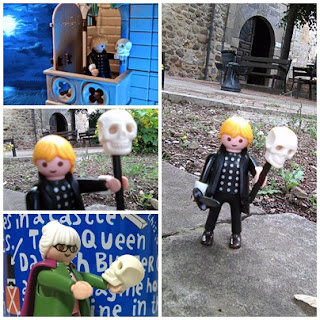 |
Today, The Grandma has read Hamlet, one of the most incredible plays written by William Shakespeare.
The Tragedy of Hamlet, Prince of Denmark, often shortened to Hamlet is a tragedy written by William Shakespeare sometime between 1599 and 1601. It is Shakespeare's longest play with 30,557 words. Set in Denmark, the play depicts Prince Hamlet and his revenge against his uncle, Claudius, who has murdered Hamlet's father in order to seize his throne and marry Hamlet's mother.
Hamlet is Shakespeare's longest play and is considered among the most powerful and influential works of world literature, with a story capable of seemingly endless retelling and adaptation by others.
It was one of Shakespeare's most popular works during his lifetime and still ranks among his most performed, topping the performance list of the Royal Shakespeare Company and its predecessors in Stratford-upon-Avon
since 1879. It has inspired many other writers -from Johann Wolfgang
von Goethe and Charles Dickens to James Joyce and Iris Murdoch- and has
been described as the world's most filmed story after Cinderella.
The story of Shakespeare's Hamlet was derived from the legend of Amleth, preserved by 13th-century chronicler Saxo Grammaticus in his Gesta Danorum, as subsequently retold by the 16th-century scholar François de Belleforest.
Shakespeare may also
have drawn on an earlier Elizabethan play known today as the Ur-Hamlet,
though some scholars believe Shakespeare wrote the Ur-Hamlet, later
revising it to create the version of Hamlet we now have. He almost
certainly wrote his version of the title role for his fellow actor,
Richard Burbage, the leading tragedian of Shakespeare's time.
In the 400
years since its inception, the role has been performed by numerous
highly acclaimed actors in each successive century.
More information: William Shakespeare
Three different early versions of the play are extant: the First Quarto (Q1, 1603); the Second Quarto (Q2, 1604); and the First Folio (F1, 1623). Each version includes lines and entire scenes missing from the others. The play's structure and depth of characterisation have inspired much critical scrutiny.
One
such example is the centuries-old debate about Hamlet's hesitation to
kill his uncle, which some see as merely a plot device to prolong the
action but which others argue is a dramatisation of the complex
philosophical and ethical issues that surround cold-blooded murder,
calculated revenge, and thwarted desire.
More recently,
psychoanalytic critics have examined Hamlet's unconscious desires, while
feminist critics have re-evaluated and attempted to rehabilitate the
often-maligned characters of Ophelia and Gertrude.
Any dating of Hamlet must be tentative, cautions the New Cambridge editor, Phillip Edwards. The earliest date estimate relies on Hamlet's frequent allusions to Shakespeare's Julius Caesar, itself dated to mid-1599.
The latest date estimate is based on an entry, of 26 July 1602, in the Register of the Stationers' Company, indicating that Hamlet was latelie Acted by the Lo: Chamberleyne his servantes.
From the early 17th century, the play was famous for its ghost and vivid dramatisation of melancholy and insanity, leading to a procession of mad courtiers and ladies in Jacobean and Caroline drama.
Much of Hamlet's language is courtly: elaborate, witty discourse, as recommended by Baldassare Castiglione's 1528 etiquette guide, The Courtier. This work specifically advises royal retainers to amuse their masters with inventive language.
Written at a time of religious upheaval and in the wake of the English Reformation, the play is alternately Catholic or piously medieval and Protestant or consciously modern.
More information: Shakespeare On Line
Hamlet is often perceived as a philosophical character, expounding ideas that are now described as relativist, existentialist, and sceptical. For example, he expresses a subjectivistic idea when he says to Rosencrantz: there is nothing either good or bad, but thinking makes it so.
Sigmund Freud's thoughts regarding Hamlet were first published in his book The Interpretation of Dreams (1899), as a footnote to a discussion of Sophocles' tragedy, Oedipus Rex, all of which is part of his consideration of the causes of neurosis.
Freud does
not offer over-all interpretations of the plays, but uses the two
tragedies to illustrate and corroborate his psychological theories,
which are based on his treatments of his patients and on his studies.
Hamlet is one of the most quoted works in the English language, and is often included on lists of the world's greatest literature.
More information: The New Yorker
One of the things that makes Hamlet
unique among Shakespeare's characters
is his courage to face up
to the darker elements of his personality.
Kenneth Branagh
No comments:
Post a Comment